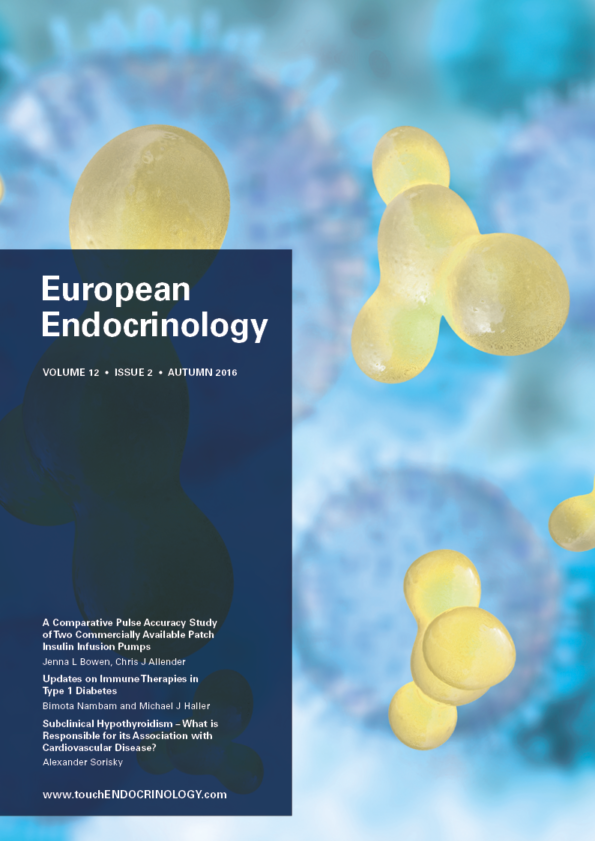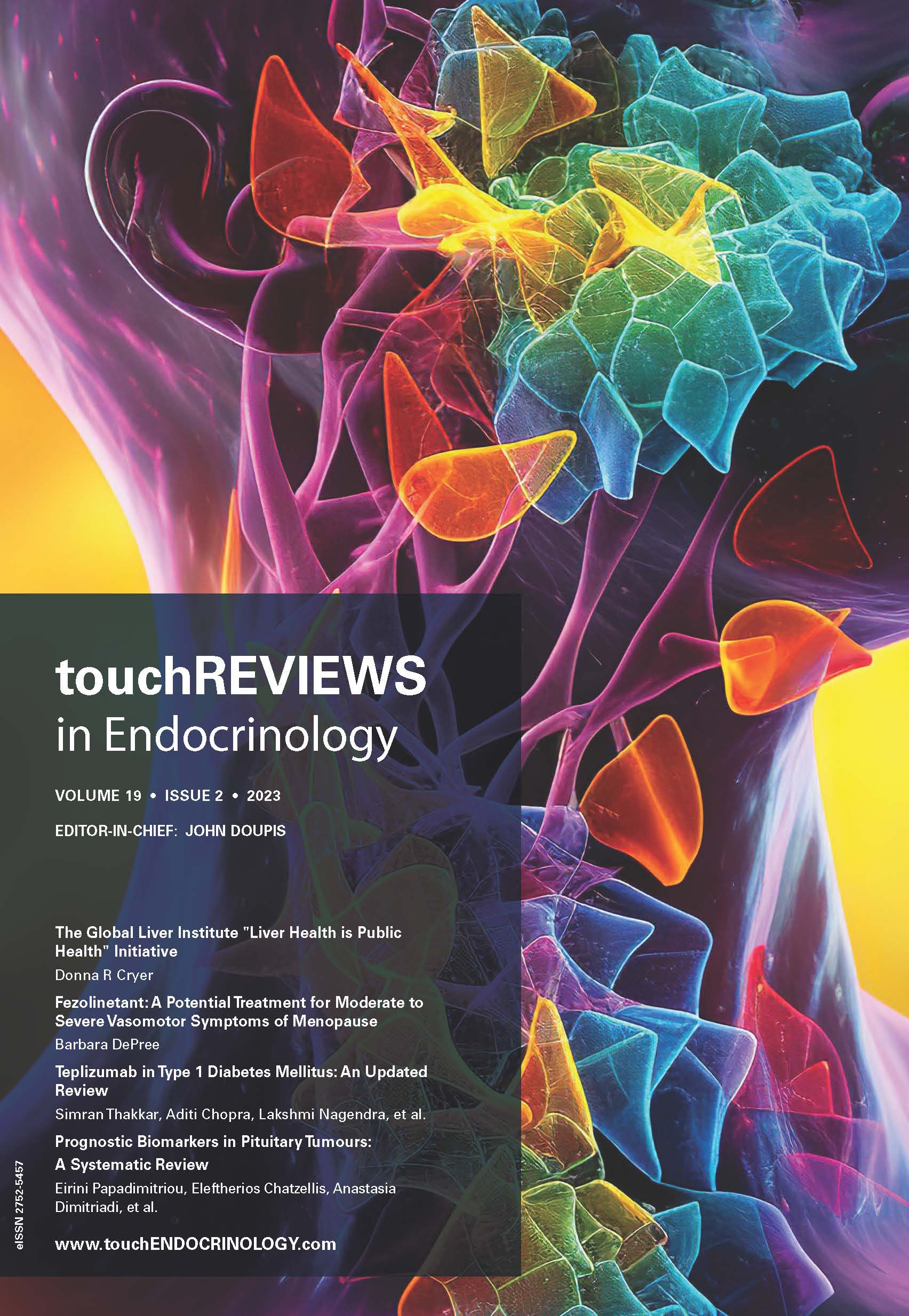EUROPEAN ENDOCRINOLOGY VOLUME 12 ISSUE 2 – AUTUMN 2016
We are pleased to welcome you to the autumn edition of European Endocrinology, which includes a selection of timely review articles and topical editorials by leading experts. There is a focus on diabetes ahead of the 52nd EASD Annual Meeting, Munich, Germany, 12-16 September 2016, where free copies will be available to collect from the literature stand. The issue begins with a topical editorial by Sanjay Kalra in which he discusses the key findings of the LEADER trial and its potential impact on clinical practice for treating type 2 diabetes.
For those not focused on diabetes other areas covered include thyroid cancer, hypothyroidism and Tumour-induced osteomalacia.
We hope you find this issue useful and that it provides helpful information and discussions that are relevant to your practice and interests. Please enjoy the expert content and we welcome any feedback you may have.
Foreword
Welcome to the latest edition of European Endocrinology, which features a range of insightful articles covering several areas of endocrinology. In recent years, a key requirement of clinical trials investigating new antidiabetes agents has been to demonstrate cardiovascular safety. An editorial by Kalra discusses the findings of the LEADER (Liraglutide Effect and Action in Diabetes: […]
Editorial
The LEADER (Liraglutide Effect and Action in Diabetes: Evaluation of Cardiovascular Outcome Results – A Long Term Evaluation) trial recently reported the cardiovascular (CV) benefits achieved with liraglutide therapy in type 2 diabetes mellitus (T2DM). In a multinational, randomised, doubleblind trial involving 9340 participants, with a median follow-up of 3.8 years, various primary and secondary […]
Original Research
Insulin pumps provide a convenient way of delivering a continuous subcutaneous insulin infusion (CSII). Devices are highly flexible to individual patient needs, allowing personalised 24-hour basal infusions and on-demand bolus delivery for acute periods of elevated blood glucose (for example, carbohydrate consumption during meals). Insulin pumps offer patients certain advantages over multiple daily injection (MDI) […]
The latest epidemiological studies have demonstrated that the prevalence of thyroid nodules in adults has reached an alarming 50–67%.1,2 Nonsurgical, minimally invasive modalities, such as ethanol ablation, laser ablation, radiofrequency ablation (RFA), and high-intensity focused ultrasound have also been reported to be effective options in treating thyroid nodules.3 Since the first reported series in 2006, […]
Review
Despite the introduction of newer and faster acting insulin analogues along with advances in glucose monitoring and insulin delivery technology, the majority of patients with type 1 diabetes (T1D) fail to achieve target glycemic control. There still remains a high burden of long term endorgan complications of T1D. Consequently, researchers continue to search for treatment […]
Subclinical hypothyroidism (SH), sometimes referred to as mild hypothyroidism, is a cumbersome term used to describe the compensatory increase in thyroid-stimulating hormone (TSH) levels to preserve normal thyroid hormone levels before they fall below normal, thus averting thyroid gland failure. An unresolved issue is whether SH merits treatment when diagnosed, or whether observation is acceptable […]
The human foetus is capable of producing thyroid hormones at around 20 weeks of gestation. Even in the rare event that there happens to be a defect in thyroid organogenesis or an inborn error in thyroid hormone synthesis, the developing foetal brain is protected by the trans-placental supply of maternal T4. Within the cerebral cortex […]
Case Report
Oncogenic osteomalcia, also known as tumour-induced osteomalacia (TIO), is a rare paraneoplasatic syndrome with around 350 reported cases.1 TIO initial symptoms are nonspecific and include fatigue, bone pain, muscle weakness, weight, and height loss, and later bone deformity and fractures. It is characterised by hypophosphatemia, hyperphosphaturia, elevated alkaline phosphatase, and low serum 1-25(OH) vitamin D. […]
US Endocrinology Highlights
Recent developments in diabetes technology— CSII, AP and CGM We are currently in an extremely exciting time for diabetes technology which holds near-term promise to substantially improve the lives of children with type 1 diabetes (T1D). Recent data published by the Type 1 Diabetes Exchange confirms what clinical experience has shown for years, that diabetes […]
Statins, first approved for general use in 1987 based on their low-density lipoprotein cholesterol (LDL-C) lowering ability, took another decade to demonstrate cardiovascular disease (CVD) benefit.1–4 Since 1990 there have been more efficacious statins but only one other modestly effective LDL-C-reducing drug, ezetimibe, has been shown to significantly reduce CVD events compared to statin alone.5–8 […]
Creation of a working closed loop/artificial pancreas (CL/AP) system is one of the holy grails of type 1 diabetes mellitus (T1DM). In essence, this would be a mechanical cure for a potentially devastating chronic disease. While the CL/AP still has its limitations, the results of recent research studies are encouraging. The CL/AP system also has […]

Trending Topic
We are pleased to present the latest issue of touchREVIEWS in Endocrinology, which offers a timely and thoughtprovoking collection of articles that reflect both the continuity and evolution of diabetes and metabolic disease research. In an era where technology, public health priorities and clinical paradigms are shifting rapidly, this issue highlights the importance of evidence-based […]
Journal Archive
touchREVIEWS in Endocrinology (previously European Endocrinology) is a peer-reviewed, free-to-access, bi-annual journal comprising review articles, case reports, editorials, special reports and original research. It features balanced and comprehensive articles written by leading authorities, addressing the most important and salient developments in the field of endocrinology.
Latest articles videos and clinical updates - straight to your inbox
Log into your Touch Account
Earn and track your CME credits on the go, save articles for later, and follow the latest congress coverage.
Register now for FREE Access
Register for free to hear about the latest expert-led education, peer-reviewed articles, conference highlights, and innovative CME activities.
Sign up with an Email
Or use a Social Account.
This Functionality is for
Members Only
Explore the latest in medical education and stay current in your field. Create a free account to track your learning.
















